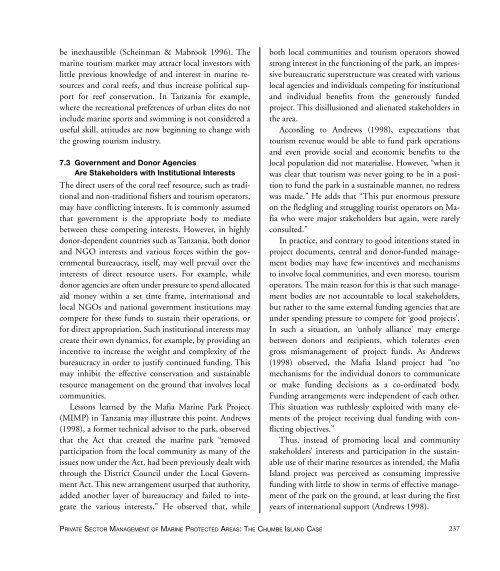You also want an ePaper? Increase the reach of your titles
YUMPU automatically turns print PDFs into web optimized ePapers that Google loves.
e inexhaustible (Scheinman & Mabrook 1996). The<br />
marine tourism market may attract local investors with<br />
little previous knowledge <strong>of</strong> and interest in marine resources<br />
and coral reefs, and thus increase political support<br />
for reef conservation. In Tanzania for example,<br />
where the recreational preferences <strong>of</strong> urban elites do not<br />
include marine sports and swimming is not considered a<br />
useful skill, attitudes are now beginning to change with<br />
the growing tourism industry.<br />
7.3 Government and Donor Agencies<br />
Are Stakeholders with Institutional Interests<br />
The direct users <strong>of</strong> the coral reef resource, such as traditional<br />
and non-traditional fishers and tourism operators,<br />
may have conflicting interests. It is commonly assumed<br />
that government is the appropriate body to mediate<br />
between these competing interests. However, in highly<br />
donor-dependent countries such as Tanzania, both donor<br />
and NGO interests and various forces within the governmental<br />
bureaucracy, itself, may well prevail over the<br />
interests <strong>of</strong> direct resource users. For example, while<br />
donor agencies are <strong>of</strong>ten under pressure to spend allocated<br />
aid money within a set time frame, international and<br />
local NGOs and national government institutions may<br />
compete for these funds to sustain their operations, or<br />
for direct appropriation. Such institutional interests may<br />
create their own dynamics, for example, by providing an<br />
incentive to increase the weight and complexity <strong>of</strong> the<br />
bureaucracy in order to justify continued funding. This<br />
may inhibit the effective conservation and sustainable<br />
resource management on the ground that involves local<br />
communities.<br />
Lessons learned by the Mafia Marine Park Project<br />
(MIMP) in Tanzania may illustrate this point. Andrews<br />
(1998), a former technical advisor to the park, observed<br />
that the Act that created the marine park “removed<br />
participation from the local community as many <strong>of</strong> the<br />
issues now under the Act, had been previously dealt with<br />
through the District Council under the Local Government<br />
Act. This new arrangement usurped that authority,<br />
added another layer <strong>of</strong> bureaucracy and failed to integrate<br />
the various interests.” He observed that, while<br />
both local communities and tourism operators showed<br />
strong interest in the functioning <strong>of</strong> the park, an impressive<br />
bureaucratic superstructure was created with various<br />
local agencies and individuals competing for institutional<br />
and individual benefits from the generously funded<br />
project. This disillusioned and alienated stakeholders in<br />
the area.<br />
According to Andrews (1998), expectations that<br />
tourism revenue would be able to fund park operations<br />
and even provide social and economic benefits to the<br />
local population did not materialise. However, “when it<br />
was clear that tourism was never going to be in a position<br />
to fund the park in a sustainable manner, no redress<br />
was made.” He adds that “This put enormous pressure<br />
on the fledgling and struggling tourist operators on Mafia<br />
who were major stakeholders but again, were rarely<br />
consulted.”<br />
In practice, and contrary to good intentions stated in<br />
project documents, central and donor-funded management<br />
bodies may have few incentives and mechanisms<br />
to involve local communities, and even moreso, tourism<br />
operators. The main reason for this is that such management<br />
bodies are not accountable to local stakeholders,<br />
but rather to the same external funding agencies that are<br />
under spending pressure to compete for ‘good projects’.<br />
In such a situation, an ‘unholy alliance’ may emerge<br />
between donors and recipients, which tolerates even<br />
gross mismanagement <strong>of</strong> project funds. As Andrews<br />
(1998) observed, the Mafia Island project had “no<br />
mechanisms for the individual donors to communicate<br />
or make funding decisions as a co-ordinated body.<br />
Funding arrangements were independent <strong>of</strong> each other.<br />
This situation was ruthlessly exploited with many elements<br />
<strong>of</strong> the project receiving dual funding with conflicting<br />
objectives.”<br />
Thus, instead <strong>of</strong> promoting local and community<br />
stakeholders’ interests and participation in the sustainable<br />
use <strong>of</strong> their marine resources as intended, the Mafia<br />
Island project was perceived as consuming impressive<br />
funding with little to show in terms <strong>of</strong> effective management<br />
<strong>of</strong> the park on the ground, at least during the first<br />
years <strong>of</strong> international support (Andrews 1998).<br />
PRIVATE SECTOR MANAGEMENT OF MARINE PROTECTED AREAS: THE CHUMBE ISLAND CASE<br />
237


















